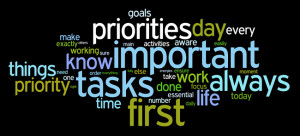 As school librarians we know students are our first priority. Most of us recognize that teachers follow close behind. Indeed where flexible scheduling exists, it’s hard to reach students without some connection with teachers. But what about your other stakeholders?
As school librarians we know students are our first priority. Most of us recognize that teachers follow close behind. Indeed where flexible scheduling exists, it’s hard to reach students without some connection with teachers. But what about your other stakeholders?
I often hear librarians complain their principal has no idea what they do. But whose fault is that? It’s our job to let administrators know what we do –and to what purpose. The challenge is doing it in a way that they listen to it. Memos are pretty much a dead form of communication – unless your administrator doesn’t handle tech well. Emails are not designed for length messages, but can be useful if used properly. So how do you reach them?
First a big Do Not .If and when your supervisor or principal drops by the library, if you are not in the middle of working with someone greet her and ask if she wants/needs something. Do not use this time to bring up any problems or concerns you have. The last thing you want is for her to associate you with complaints. If you are helping someone, excuse yourself briefly, check in with the administrator and let her know you will get back to her in a few minutes. For some reason principals seem to have a sixth sense and show up more often when the library is almost empty. Quickly explain the “lull” and say, “If you want to see the library as it usually is, I can send you a list of classes who will be coming that you might want to watch.” (That’s one good use of e-mails.)
The way to let your principal know what you do — and bring concerns to her attention is visually. Use a resource such as Animoto or, even better, Issuu to make your reports. And yes, you need to do reports even if they are not required. Monthly is usually too difficult but you should strive for quarterly. Focus on activities based on student learning (and how these connect to Common Core). Include short videos of students at work. Use graphs and other visuals to illustrate statistics. Don’t limit these to circulation figures. Look for more meaningful ones. How many students came to the library before school? After school? How many classes came? Highlight one or two outstanding projects, giving the name of the teacher. At the middle and high school, show how many different departments used the library.
Address concerns by highlighting what you are trying to achieve and why. Briefly explain what needs to be done to get there, and identify your suggestions for dealing with the obstacles. Brevity is key in all this. Avoid going into too much detail. If your principal wants more information, she’ll ask.
 The beauty of this approach is that when your report is interesting, your principal will likely include it, or at least information from it the Superintendent and from there to an important group of stakeholders most librarians forget –Board of Education members. Although not always seen in the school they ultimately play a life or death role in the library program. It is good advocacy to get to know who they are and what their chief concerns and interests are. A number of participants in my ALA Editions e-course decided to make the Board members a focus, planning to attend at least some meetings and targeting one board member a year. Do inform your principal before sending something to a Board member, but opening that channel of communication will result in more stakeholders knowing the value of the library program?
The beauty of this approach is that when your report is interesting, your principal will likely include it, or at least information from it the Superintendent and from there to an important group of stakeholders most librarians forget –Board of Education members. Although not always seen in the school they ultimately play a life or death role in the library program. It is good advocacy to get to know who they are and what their chief concerns and interests are. A number of participants in my ALA Editions e-course decided to make the Board members a focus, planning to attend at least some meetings and targeting one board member a year. Do inform your principal before sending something to a Board member, but opening that channel of communication will result in more stakeholders knowing the value of the library program?
Does your principal know what you do? How well do you know Board members?
